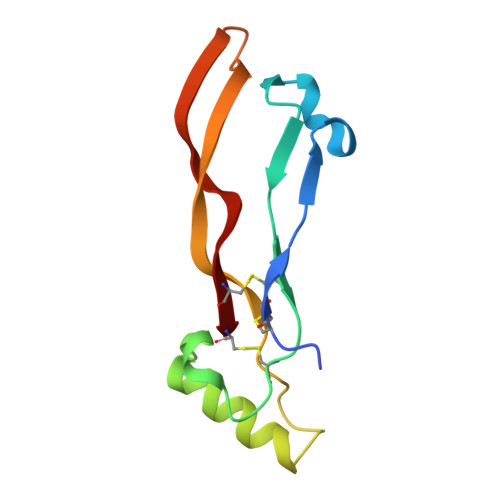Molecular Basis of Interchain Disulfide Bond Formation in BMP-9 and BMP-10.
Schwartze, T.A., Morosky, S.A., Rosato, T.L., Henrickson, A., Lin, G., Hinck, C.S., Taylor, A.B., Olsen, S.K., Calero, G., Demeler, B., Roman, B.L., Hinck, A.P.(2025) J Mol Biology 437: 168935-168935
- PubMed: 39793884
- DOI: https://doi.org/10.1016/j.jmb.2025.168935
- Primary Citation of Related Structures:
9DPM, 9DPN, 9DPO, 9DPP, 9DPQ, 9DPR, 9DPS, 9DPT, 9DPU, 9DPV, 9DPW, 9DPX, 9DPY - PubMed Abstract:
BMP-9 and BMP-10 are TGF-β family signaling ligands naturally secreted into blood. They act on endothelial cells and are required for proper development and maintenance of the vasculature. In hereditary hemorrhagic telangiectasia, regulation is disrupted due to mutations in the BMP-9/10 pathway, namely in the type I receptor ALK1 or the co-receptor endoglin. It has been demonstrated that BMP-9/10 heterodimers are the most abundant signaling species in the blood, but it is unclear how they form. Unlike other ligands of the TGF-β family, BMP-9 and -10 are secreted as a mixture of disulfide-linked dimers and monomers, in which the interchain cysteine (Cys-392) remains either paired or unpaired. Here, we show that the monomers are secreted in a cysteinylated form that crystallizes as a non-covalent dimer. Despite this, monomers do not self-associate at micromolar or lower concentrations and have reduced signaling potency compared to disulfide-linked dimers. We further show using protein crystallography that the interchain disulfide of the BMP-9 homodimer adopts a highly strained syn-periplanar conformation. Hence, geometric strain across the interchain disulfide is responsible for infrequent interchain disulfide bond formation, not the cysteinylation. Additionally, we show that interchain disulfide bond formation occurs less in BMP-9 than BMP-10 and these frequencies can be reversed by swapping residues near the interchain disulfide that form attractive interactions with the opposing protomer. Finally, we discuss the implications of these observations on BMP-9/10 heterodimer formation.
- Department of Structural Biology, School of Medicine, University of Pittsburgh, Pittsburgh, PA 15260, USA.
Organizational Affiliation:


















